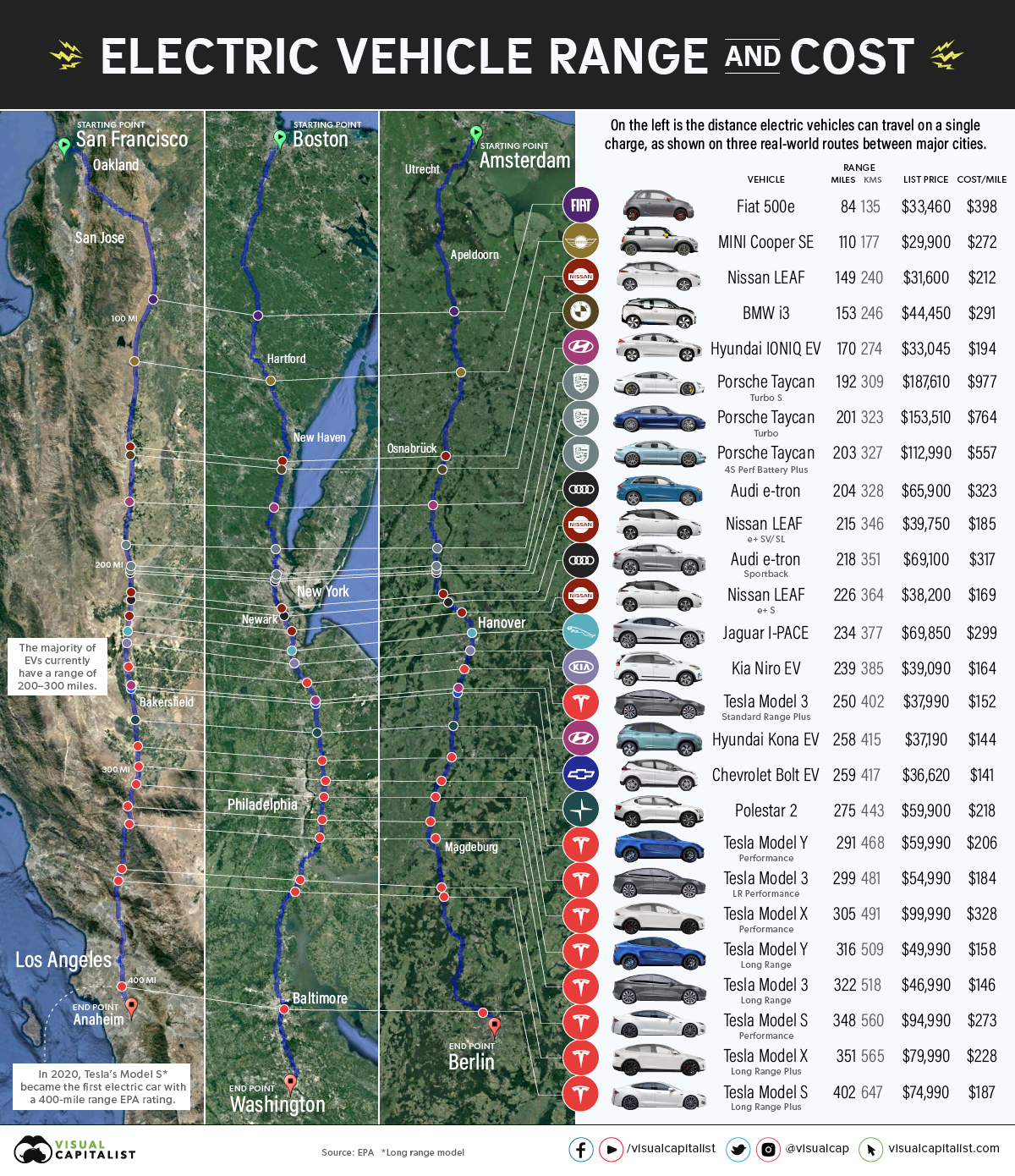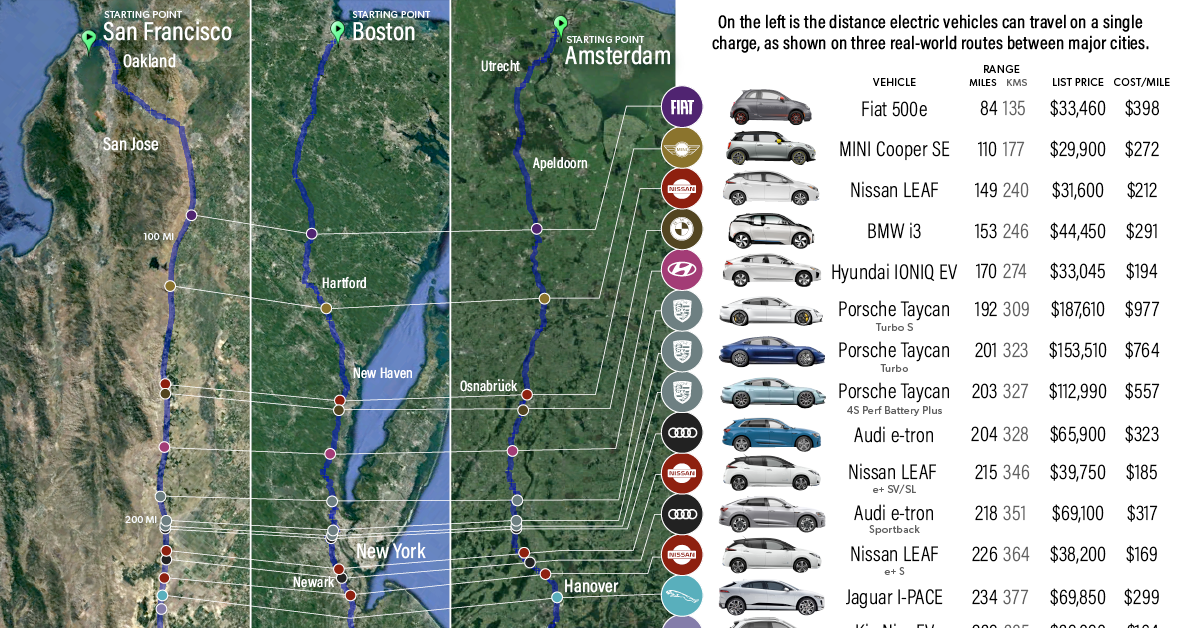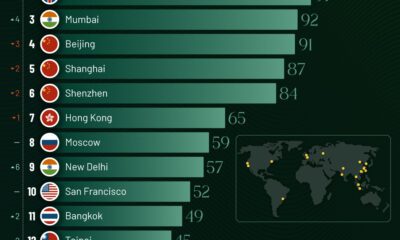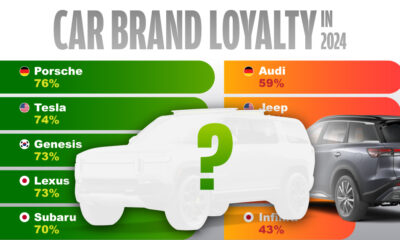Energy
Visualizing the Range of EVs on Major Highway Routes

The Range of EVs on Major Highway Routes
Between growing concerns around climate change, new commuting behaviors due to COVID-19, and imminent policy changes, the global transition to electric vehicles (EVs) is well under way.
By the year 2040, sales of electric vehicles are projected to account for 58% of new car sales, up from just 2.7% currently.
But switching from a gasoline car to an electric one is not seamless. With charging and range capacities to consider, and the supporting infrastructure still being slowly rolled out in many parts of the world, understanding the realities of EV transportation is vital.
Above, we highlight 2020 all-electric vehicle range on well-recognized routes, from California’s I-5 in the U.S. to the A2 autobahn in Germany. The data on estimated ranges and costs are drawn from the U.S. EPA as well as directly from manufacturer websites.
The EV Breakdown: Tesla is King of Range
For many consumers, the most important aspect of an electric vehicle is how far they can travel on a single charge.
Whether it’s for long commutes or out-of-city trips, vehicles must meet a minimum threshold to be considered practical for many households. As the table below shows, Tesla’s well-known EVs are far-and-away the best option for long range drivers.
| Vehicle | Range (miles) | Range (km) | MSRP | Cost per mile |
|---|---|---|---|---|
| Tesla Model S Long Range Plus | 402 | 647 | $74,990 | $186.54 |
| Tesla Model X Long Range Plus | 351 | 565 | $79,990 | $227.89 |
| Tesla Model S Performance | 348 | 560 | $94,990 | $272.96 |
| Tesla Model 3 Long Range | 322 | 518 | $46,990 | $145.93 |
| Tesla Model Y Long Range | 316 | 509 | $49,990 | $158.20 |
| Tesla Model X Performance | 305 | 491 | $99,990 | $327.84 |
| Tesla Model 3 LR Performance | 299 | 481 | $54,990 | $183.91 |
| Tesla Model Y Performance | 291 | 468 | $59,990 | $206.15 |
| Polestar 2 | 275 | 443 | $59,900 | $217.82 |
| Chevrolet Bolt EV | 259 | 417 | $36,620 | $141.39 |
| Hyundai Kona Electric | 258 | 415 | $37,190 | $144.15 |
| Tesla Model 3 Standard Range Plus | 250 | 402 | $37,990 | $151.96 |
| Kia Niro EV | 239 | 385 | $39,090 | $163.56 |
| Jaguar I-PACE | 234 | 377 | $69,850 | $298.50 |
| Nissan LEAF e+ S | 226 | 364 | $38,200 | $169.03 |
| Audi e-tron Sportback | 218 | 351 | $69,100 | $316.97 |
| Nissan LEAF e+ SV/SL | 215 | 346 | $39,750 | $184.88 |
| Audi e-tron | 204 | 328 | $65,900 | $323.04 |
| Porsche Taycan 4S Perf Battery Plus | 203 | 327 | $112,990 | $556.60 |
| Porsche Taycan Turbo | 201 | 323 | $153,510 | $763.73 |
| Porsche Taycan Turbo S | 192 | 309 | $187,610 | $977.14 |
| Hyundai IONIQ Electric | 170 | 274 | $33,045 | $194.38 |
| BMW i3 | 153 | 246 | $44,450 | $290.52 |
| Nissan LEAF | 149 | 240 | $31,600 | $212.08 |
| MINI Cooper SE | 110 | 177 | $29,900 | $271.82 |
| Fiat 500e | 84 | 135 | $33,460 | $398.33 |
In an industry where innovation and efficiency are vital, Tesla’s first-mover advantage is evident. From the more affordable Model 3 to the more luxurious Model S, the top eight EVs with the longest ranges are all Tesla vehicles.
At 402 miles (647 km), the range of the number one vehicle (the Tesla Model S Long Range Plus) got 127 miles more per charge than the top non-Tesla vehicle, the Polestar 2—an EV made by Volvo’s standalone performance brand.
Closer Competition in Cost
Though Tesla leads on overall range and battery capacity, accounting for the price of each vehicle shows that cost-efficiency is far more competitive among brands.
By dividing the retail price by the maximum range of each vehicle, we can paint a clearer picture of efficiency. Leading the pack is the Chevrolet Bolt, which had a cost of $141.39/mile of range in 2020 while still placing in the top 10 for range with 259 miles (417 km).
Just behind in second place was the Hyundai Kona electric at $144.15/mile of range, followed by the Tesla Model 3—the most efficient of the automaker’s current lineup. Rounding out the top 10 are the Nissan LEAF and Tesla Model S, but the difference from number one to number ten was minimal, at just over $45/mile.
| Top 10 All-Electric Vehicles by Cost Efficiency | |
|---|---|
| Vehicle | Cost per mile |
| Chevrolet Bolt EV | $141.39 |
| Hyundai Kona Electric | $144.15 |
| Tesla Model 3 Long Range | $145.93 |
| Tesla Model 3 Standard Range Plus | $151.96 |
| Tesla Model Y Long Range | $158.20 |
| Kia Niro EV | $163.56 |
| Nissan LEAF e+ S | $169.03 |
| Tesla Model 3 LR Performance | $183.91 |
| Nissan LEAF e+ SV/SL | $184.88 |
| Tesla Model S Long Range Plus | $186.54 |
Higher Ranges and Lower Costs on the Horizon
The most important thing to consider, however, is that the EV industry is entering a critical stage.
On one hand, the push for electrification and innovation in EVs has driven battery capacity higher and costs significantly lower. As batteries account for the bulk of weight, cost, and performance in EVs, those dividends will pay out in longer ranges and greater efficiencies with newer models.
Equally important is the strengthening global push for electric vehicle adoption. In countries like Norway, EVs are already among the best selling cars on the market, while adoption rates in China and the U.S. are steadily climbing. This is also being impacted by policy decisions, such as California’s recent announcement that it would be banning the sale of gasoline cars by 2035.
Meanwhile, the only thing outpacing the growing network of Tesla superchargers is the company’s rising stock price. Not content to sit on the sidelines, competing automakers are rapidly trying to catch up. Nissan’s LEAF is just behind the Tesla Model 3 as the world’s second-best-selling EV, and Audi recently rolled out a supercharger network that can charge its cars from 0% to 80% at a faster rate than Tesla.
As the tidal wave of electric vehicle demand and adoption continues to pick up steam, consumers can expect increasing innovation to drive up ranges, decrease costs, and open up options.
Correction: A previous version of this graphic showed a European route that was the incorrect distance.
Energy
Charted: 4 Reasons Why Lithium Could Be the Next Gold Rush
Visual Capitalist has partnered with EnergyX to show why drops in prices and growing demand may make now the right time to invest in lithium.

4 Reasons Why You Should Invest in Lithium
Lithium’s importance in powering EVs makes it a linchpin of the clean energy transition and one of the world’s most precious minerals.
In this graphic, Visual Capitalist partnered with EnergyX to explore why now may be the time to invest in lithium.
1. Lithium Prices Have Dropped
One of the most critical aspects of evaluating an investment is ensuring that the asset’s value is higher than its price would indicate. Lithium is integral to powering EVs, and, prices have fallen fast over the last year:
| Date | LiOH·H₂O* | Li₂CO₃** |
|---|---|---|
| Feb 2023 | $76 | $71 |
| March 2023 | $71 | $61 |
| Apr 2023 | $43 | $33 |
| May 2023 | $43 | $33 |
| June 2023 | $47 | $45 |
| July 2023 | $44 | $40 |
| Aug 2023 | $35 | $35 |
| Sept 2023 | $28 | $27 |
| Oct 2023 | $24 | $23 |
| Nov 2023 | $21 | $21 |
| Dec 2023 | $17 | $16 |
| Jan 2024 | $14 | $15 |
| Feb 2024 | $13 | $14 |
Note: Monthly spot prices were taken as close to the 14th of each month as possible.
*Lithium hydroxide monohydrate MB-LI-0033
**Lithium carbonate MB-LI-0029
2. Lithium-Ion Battery Prices Are Also Falling
The drop in lithium prices is just one reason to invest in the metal. Increasing economies of scale, coupled with low commodity prices, have caused the cost of lithium-ion batteries to drop significantly as well.
In fact, BNEF reports that between 2013 and 2023, the price of a Li-ion battery dropped by 82%.
| Year | Price per KWh |
|---|---|
| 2023 | $139 |
| 2022 | $161 |
| 2021 | $150 |
| 2020 | $160 |
| 2019 | $183 |
| 2018 | $211 |
| 2017 | $258 |
| 2016 | $345 |
| 2015 | $448 |
| 2014 | $692 |
| 2013 | $780 |

3. EV Adoption is Sustainable
One of the best reasons to invest in lithium is that EVs, one of the main drivers behind the demand for lithium, have reached a price point similar to that of traditional vehicle.
According to the Kelly Blue Book, Tesla’s average transaction price dropped by 25% between 2022 and 2023, bringing it in line with many other major manufacturers and showing that EVs are a realistic transport option from a consumer price perspective.
| Manufacturer | September 2022 | September 2023 |
|---|---|---|
| BMW | $69,000 | $72,000 |
| Ford | $54,000 | $56,000 |
| Volkswagon | $54,000 | $56,000 |
| General Motors | $52,000 | $53,000 |
| Tesla | $68,000 | $51,000 |
4. Electricity Demand in Transport is Growing
As EVs become an accessible transport option, there’s an investment opportunity in lithium. But possibly the best reason to invest in lithium is that the IEA reports global demand for the electricity in transport could grow dramatically by 2030:
| Transport Type | 2022 | 2025 | 2030 |
|---|---|---|---|
| Buses 🚌 | 23,000 GWh | 50,000 GWh | 130,000 GWh |
| Cars 🚙 | 65,000 GWh | 200,000 GWh | 570,000 GWh |
| Trucks 🛻 | 4,000 GWh | 15,000 GWh | 94,000 GWh |
| Vans 🚐 | 6,000 GWh | 16,000 GWh | 72,000 GWh |
The Lithium Investment Opportunity
Lithium presents a potentially classic investment opportunity. Lithium and battery prices have dropped significantly, and recently, EVs have reached a price point similar to other vehicles. By 2030, the demand for clean energy, especially in transport, will grow dramatically.
With prices dropping and demand skyrocketing, now is the time to invest in lithium.
EnergyX is poised to exploit lithium demand with cutting-edge lithium extraction technology capable of extracting 300% more lithium than current processes.

-

 Lithium5 days ago
Lithium5 days agoRanked: The Top 10 EV Battery Manufacturers in 2023
Asia dominates this ranking of the world’s largest EV battery manufacturers in 2023.
-

 Energy1 week ago
Energy1 week agoThe World’s Biggest Nuclear Energy Producers
China has grown its nuclear capacity over the last decade, now ranking second on the list of top nuclear energy producers.
-

 Energy1 month ago
Energy1 month agoThe World’s Biggest Oil Producers in 2023
Just three countries accounted for 40% of global oil production last year.
-

 Energy1 month ago
Energy1 month agoHow Much Does the U.S. Depend on Russian Uranium?
Currently, Russia is the largest foreign supplier of nuclear power fuel to the U.S.
-

 Uranium2 months ago
Uranium2 months agoCharted: Global Uranium Reserves, by Country
We visualize the distribution of the world’s uranium reserves by country, with 3 countries accounting for more than half of total reserves.
-

 Energy3 months ago
Energy3 months agoVisualizing the Rise of the U.S. as Top Crude Oil Producer
Over the last decade, the United States has established itself as the world’s top producer of crude oil, surpassing Saudi Arabia and Russia.
-

 Debt1 week ago
Debt1 week agoHow Debt-to-GDP Ratios Have Changed Since 2000
-

 Countries2 weeks ago
Countries2 weeks agoPopulation Projections: The World’s 6 Largest Countries in 2075
-

 Markets2 weeks ago
Markets2 weeks agoThe Top 10 States by Real GDP Growth in 2023
-

 Demographics2 weeks ago
Demographics2 weeks agoThe Smallest Gender Wage Gaps in OECD Countries
-

 United States2 weeks ago
United States2 weeks agoWhere U.S. Inflation Hit the Hardest in March 2024
-

 Green2 weeks ago
Green2 weeks agoTop Countries By Forest Growth Since 2001
-

 United States2 weeks ago
United States2 weeks agoRanked: The Largest U.S. Corporations by Number of Employees
-

 Maps2 weeks ago
Maps2 weeks agoThe Largest Earthquakes in the New York Area (1970-2024)


















